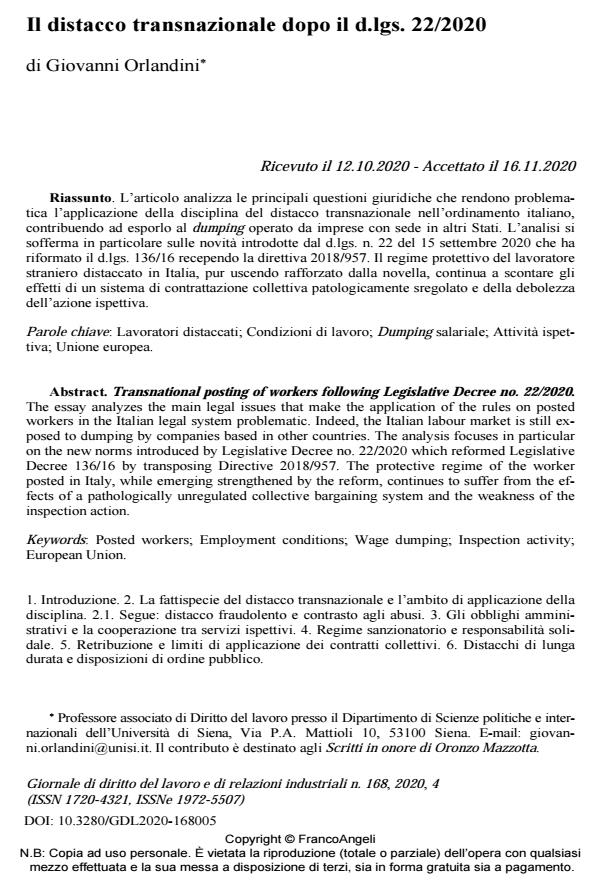Transnational posting of workers following Legislative Decree no. 22/2020
Journal title GIORNALE DI DIRITTO DEL LAVORO E DI RELAZIONI INDUSTRIALI
Author/s Giovanni Orlandini
Publishing Year 2021 Issue 2020/168
Language Italian Pages 17 P. 749-765 File size 263 KB
DOI 10.3280/GDL2020-168005
DOI is like a bar code for intellectual property: to have more infomation
click here
Below, you can see the article first page
If you want to buy this article in PDF format, you can do it, following the instructions to buy download credits

FrancoAngeli is member of Publishers International Linking Association, Inc (PILA), a not-for-profit association which run the CrossRef service enabling links to and from online scholarly content.
The essay analyzes the main legal issues that make the application of the rules on posted workers in the Italian legal system problematic. Indeed, the Italian labour market is still ex-posed to dumping by companies based in other countries. The analysis focuses in particular on the new norms introduced by Legislative Decree no. 22/2020 which reformed Legislative De-cree 136/16 by transposing Directive 2018/957. The protective regime of the worker posted in Italy, while emerging strengthened by the reform, continues to suffer from the effects of a pathologically unregulated collective bargaining system and the weakness of the inspection action.
Keywords: Posted workers; Employment conditions; Wage dumping; Inspection activity; Eu-ropean Union.
- Aa. Allamprese A. (2007). Distacco dei lavoratori stranieri nel quadro di una prestazione transnazionale di servizi: profili previdenziali. PAPP, I: 1 ss.
- Berntsen L., Lillie N. (2016). Hyper-mobile migrant workers and Duch trade union representation strategies at the Eemshaven construction site. EID: 171 ss.
- Borelli S. (2019). “Which way I ought to go from here? The European Labour Authority in the Internal Market Regulation. In Borelli S., Guazzarotti A., a cura di, Labour Mobility and International Solidarity in the European Union. Napoli: Jovene, 143 ss.,
- Borelli S. (2020). Il distacco di lavoratori migranti. In Chiaromonte W., Ferrara M.D., Ranieri M., a cura di, Migranti e lavoro. Bologna: il Mulino, 301 ss.
- Centamore G. (2020). Contrattazione collettiva e pluralità di categorie. Bologna: Bononia University Press.
- Cordella C. (2019). L’ordine pubblico nel distacco transnazionale dei lavoratori. DLM: 263 ss.
- Davies P. (1997). Single Market or Protection of National Labour Systems?. CMLR: 571 ss.
- Dovere S., Pascucci P. (2020). Covid-19 e tutela della salute e sicurezza dei lavoratori. DLRI: 373 ss.
- Frosecchi G. (2018). Distacco, cabotaggio e trasporto internazionale: un puzzle ancora da comporre. Quaderni RGL, 3: 43 ss.
- Giubboni S., Orlandini G. (2018). Il dumping sociale in Europa, oggi. DLRI: 907 ss.
- Iannuzzi F.E., Sacchetto D. (2020). Italian Labour Inspectors Facing Posted Workers Phenomena. In: Arnholtz J., Lillie N., eds., Posted Work in European Union. The Political Economy of Free Movement. London: Routledge, 109 ss.
- Mattei A. (2017). La Direttiva Enforcement 2014/67 e il recepimento nell’ordinamento italiano. RGL, I: 147 ss.
- Orlandini G. (2020). Salari e contrattazione alla prova del mercato interno. LD: 285 ss.
- Pallini M. (2017). Gli appalti transnazionali: la disciplina italiana al vaglio di conformità con il diritto europeo. RGL, I: 485 ss.
- Pascucci P. (2018). Giusta retribuzione e contratti di lavoro. Verso un salario minimo legale?. Milano: Franco Angeli.
- Rasnača Z. (2019). Reimbursement rules for posted workers: mapping national law in the EU28. Bruxelles: ETUI.
- Rasnača Z. (2020). Essential but unprotected: highly mobile workers in the EU during the COVID-19 pandemic. ETUI Policy Brief 9/2020.
- Razzolini O. (2018). Azione sindacale e tutela giurisdizionale. Studio preliminare a partire da un’analisi comparata. Milano: Franco Angeli.
- Rocca M. (2020). One train! (But different working conditions). AA, 3, in corso di pubblicazione.
- Sgroi A. (2011). Il distacco dei lavoratori nel quadro del Regolamento Cee n. 1408/71 e del Regolamento Cee n. 883/04. In: Cosio R., Foglia R., a cura di, Il diritto del lavoro dell’Unione Europea. Milano: Giuffrè.
- van Hoeck A., Houwerzijl M. (2016). Where do EU mobile workers belong, according to Rome I and the (E)PWD?. In: Verschueren H., ed., Residence, employment and social rights of mobile persons: on how EU law defines where they belong. Cambridge: Cambridge University Press, 215 ss.
- Venturi P. (2018). Il distacco transnazionale di lavoratori: luci e ombre del d.lgs. n. 136/2016. Working Paper n. 2. Modena: Adapt University Press.
Giovanni Orlandini, Il distacco transnazionale dopo il d.lgs. 22/2020 in "GIORNALE DI DIRITTO DEL LAVORO E DI RELAZIONI INDUSTRIALI " 168/2020, pp 749-765, DOI: 10.3280/GDL2020-168005